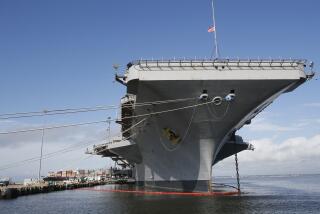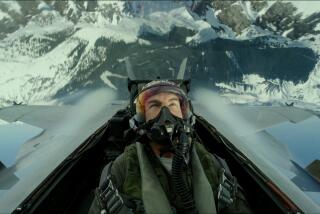‘Supercarrier’ Torpedoed by the U.S. Navy
- Share via
NEW YORK — At issue was how men go down to the sea in scripts.
Producer Charles Fries said he and ABC thought action-adventure was the way to go with the new “Supercarrier” series. But the Navy didn’t think the scripts accurately portrayed it or its people.
And so, even though it had no objections to last Sunday’s opening episode, the Navy last Friday yanked its support of “Supercarrier” because of differences over future plots in the six other episodes still on tap.
The problem, a Navy spokesman said Wednesday, is that in the remaining shows the Navy “just becomes a backdrop” for action-adventure stories having little or nothing to do with the Navy or its mission.
The parting was not acrimonious, and there still is a chance that Navy support will be reinstated if there is a meeting of naval and Hollywood minds on future scripts for the series, emphasized the spokesman, Capt. Michael Sherman, director of the Navy’s West Coast information office.
He declined to be specific about plots the Navy had found objectionable, but laughed at a report that officials were disturbed at one in which the captain of the show’s aircraft carrier falls in love with a female jet pilot. “I never saw a story line like that,” he said.
The show, set aboard the fictional carrier Georgetown, has been likened to a small-screen version of the hit movie “Top Gun,” right down to the rock music that accompanies the launching of F-14 jet fighters.
Co-produced by Fries’ production company, ABC’s series is vaguely based on “Supercarrier,” a best-selling, nonfiction book by Washington Post reporter George Wilson--who didn’t think much of the show’s premiere.
The aerial photography was fine, but the script “was full of bromides,” said Wilson, who spent seven months aboard the aircraft carrier John F. Kennedy in 1983, gathering material for his book.
“I was kind of distressed that they didn’t get it a little more realistic in terms of what really goes on out there,” he said, adding that one admiral sternly told him: “You ought to sue ABC for not plagiarizing your book.”
Parts of the series were filmed aboard the Kennedy, and at naval facilities in Norfolk, Va., Florida and Long Beach, Calif. The Navy charged Fries’ company $50,000 for the use of Navy personnel, planes and facilities.
The series initially planned to concentrate on the lives of the men and women in the Navy, focusing on the carrier, Fries said, but the pilot episode proved so exciting that the series’ emphasis was changed to action-adventure.
“From that point on, the Navy became more and more disenchanted because essentially they’re concerned about their perception (by the public),” he said. “Right now, the Navy is in a peacetime mode . . . but to do an action-adventure show we had to get off the carrier and bring in some conflict and jeopardy.”
Fries, who, like the Navy’s Sherman, was interviewed by phone from Los Angeles, said he had ample shipboard footage left from the filming of the first episode and could continue production without Navy help. Only two episodes remain to be shot.
The show shoots its interior sequences on a carrier mock-up set in Valencia, Fries said, and probably could film aboard two old carriers that now are floating museums--the Intrepid here and the Yorktown in Charleston, S.C.
But he said there is a chance the Navy might resume its support--provided that ABC renews the series for the fall--if it sees “a positive response” from the public: “I think they’re in a wait-and-see mode.”
The Navy’s action wasn’t its first for a TV series. It also initially lent support for, then withdrew it from CBS’ “Emerald Point N.A.S.” series of 1983-84. While land-based, that show also concerned Navy fliers. The Navy dropped out because the series had become “too much of a soap opera,” Sherman recalled.
The general rule for military support of a film or television series, a Pentagon spokesman said, is that the project will benefit the Defense Department or otherwise be in the national interest.
The rules of engagement include authenticity in the portrayal of military operations or historical incident and what one Pentagon official has called “a true interpretation of military life.”
“Top Gun” had Navy support, but not “An Officer and a Gentleman.” CBS’s current Vietnam series, “Tour of Duty,” has Army support for its filming in Hawaii.
More to Read
The complete guide to home viewing
Get Screen Gab for everything about the TV shows and streaming movies everyone’s talking about.
You may occasionally receive promotional content from the Los Angeles Times.





